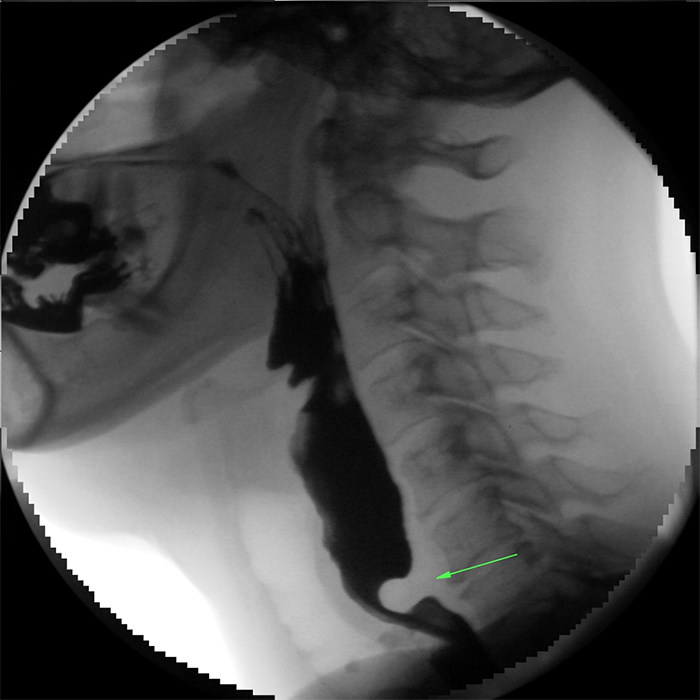Swallowing information for Cricopharyngeal Muscle Dysfunction
Definition:
Swallowing is a complicated sequence of both voluntary and reflex movements, which needs your brain to coordinate many muscles and nerves.
Dysphagia is the medical term for a sensation of difficulty or abnormality of swallowing. It can happen rapidly, or slowly and has many causes.
The cricopharyngeal (CP) muscle is the major component of the upper oesophageal sphincter, (UOS). It is a 1-2 cm wide, ring-like muscle thatis normally constantly contracted, like a valve at the top of the oesophagus, except during swallowing. SEE Fig. 1. The other components of the UOS include the lower pharyngeal muscles, and the upper oesophageal muscles.
Cricopharyngeal (CP) Bar is a ridge-like thickening of the back wall of the cricopharyngeal muscle seen on XR swallow testsas an indentation of the upper oesophagus. It is thought to be due to scarring and reduced stretch of the CP muscle. It can be an asymptomatic, incidental finding or it may cause dysphagia. Sometimes, even when dysphagia is present it is not due to the bar itself, but other additional causes.
Cricopharyngeal (CP) spasmor muscle dysfunction is a constellation of problems that can cause dysphagia or canhappen without any significant swallowing difficulties (known more as globus pharyngeus). CP Dysfunction occurs when the muscles contract too much between or during swallows, or fail to relax to allow opening of the upper oesophageal sphincterduring a swallow.
Causes:
Several neurological conditions, nerve injuries and structural and mechanical disorders such as pharyngeal diverticula can cause this condition although other factors have also been shown to cause or increase symptoms such as reflux and stress.
Diagnosis:
The diagnosis of dysphagia involves a thorough case history, clinical examination of the muscles and nerves required for swallowing, digital nasendoscopy of the upper airway and pharynx, and an instrumental swallowing evaluation such as Flexible Endoscopic Evaluation of Swallowing and/or a Videofluoroscopy Swallowing Study (VFSS).
Additional tests may be required such as a standard barium swallow, High Resolution Pharyngeal and Oesophageal Manometry, 24 hr pH/Impedance monitoring and/or oral salivary pepsin testing (Peptest). A validated questionnaire, called a patient-related outcome measure, is often completed initially, and repeated later on to measure your progress. E.g. Eat-10 or SWAL-QOL.

Fig. 1 –Cricopharyngeal bar on Video-fluoroscopy
Symptoms you might experience in the diagnosis of Cricopharyngeal muscle dysfunction include:
- a sensation of a lump in the throat sensation,
- difficulty swallowing solids +/-liquids
- coughing or choking after swallowing
- a frequent need to re-swallow after solid foods
- regurgitation of food or drink intake into your nose or mouth
If you can’t swallow correctly then food and drink may be getting into your airway and lungs. This is called aspiration. If this happens it can lead to infections and pneumonia, which can be very serious. It is important that any changes to your swallowing are identified early, to avoid this happening.
Management:
Once you have had a complete swallowing evaluation, the swallowing specialists can recommend ways to improve your ability to eat and drink depending on the specific problems found. There are a variety of different treatment options depending on the cause/s and severity of presentation. For example, if a CP Bar is present, but asymptomatic, there is no need to treat the bar. But if dysphagia is moderate to severe, then the options below may be employed.
- Procedural/SurgicalTreatments:
- Botulinum Toxin (Botox®)injection: This injection can be performed through the mouth (endoscopic), or through the neck (percutaneous). The Endoscopic route requires a general anaesthetic. Botox temporarily paralyses the muscle fibres in the CP, allowing better relaxation and stretching, the result usually lasting 3-4 months, but sometimes longer. Treatments can be repeated.
- Mechanical Dilation (Balloon): This is performed through the mouth (endoscopically), and usually requires a general anaesthetic. The balloon is placed through the region of the CP muscle and inflated causing stretch, and breakdown of scar fibres within the CP muscle. Again, treatments can be repeated. SEE Fig.2
- Cutting of the CP Muscle(CP Myotomy): This operation is most commonly performed through the mouth (endoscopic myotomy), without any cuts in the neck , though sometimes the muscle is approached through a cut in the neck (open myotomy). Most surgeons employ a Laser to perform the cut. The risk for complication is higher than for botox or balloon, however it is generally a very effective treatment option, perhaps more so than Botox® or Balloon.

- Swallowing Modifications:
- General strategies to improve swallowing safety such as tucking chin down, turning head to side, may be employed.
- Safe swallowing strategies such as eating slowly or taking smaller mouthfuls, may also be advised.
- Specific swallow rehabilitative exercises may also be recommended by a speech pathologist to facilitate relaxation of the CP muscle – such as the Shaker Exercise, and the Mendelsohn manoeuvre.
- Dietary Modification
- Thickening drinks with special powders to make them easier to swallow.
- Softening your food to make it easier to chew and swallow.
Initial recommendations:
- Take your time when eating and drinking
- Avoid distractions such as television and other people
- Use a teaspoon to take smaller mouthfuls
- Eat smaller meals more often if swallowing is tiring.
- Ask your GP or physician today whether you need a swallowing evaluation.
- See your GP urgently if you are coughing and choking after swallowing, have a fever, or a productive cough.
